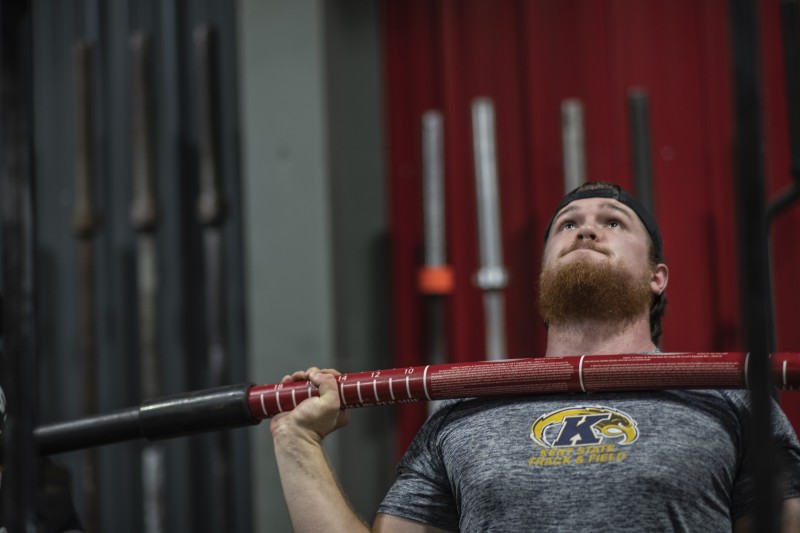
What To Expect
In the first two articles of this series, some general guidelines were explained regarding how to avoid the accumulation of fatigue and injury. Now some specific guidelines will be offered as programming variations for a similar audience. That audience is mainly intermediate lifters over 40, but this can also help anyone stalling in their current program.
RECENT: Three More Guidelines for Injury-Free Progress
To keep things coherent, let us revisit the six points taken from the first two articles, “Basic Guidelines for Injury-Free Progress” and “Three More Guidelines for Injury-Free Progress,” as our underlying philosophy:
- Just because you can doesn’t mean you should
- Stay hungry
- Find the sweet spot
- Use the minimum effective dose for your goal
- Assess and address imbalances regularly
- Be process-oriented
The central theme of this article is how to control intensity using a variety of methods in planning, monitoring, and controlling training in accordance with these principles.

Regarding Concurrent Training of Strength and Conditioning
You should ask yourself, “If I train strength and conditioning at the same time, will both suffer?”
Unless you are taxing your recovery or training in completely disparate ways, you can train both domains. First, if you train in ways that tax recovery, you will suffer from interference. For example, you finish a maximal strength block feeling great in your squat weight, technique, and speed, then you start the conditioning block with a 400-meter walking lunge workout. You will likely have destroyed your gains with such a foolish choice of exercise.
Note: In this article, sub-maximal refers to 70 to 90 percent intensity; circa-maximal is 90 to 97 percent intensity; 97 to 100 percent intensity is maximal intensity; and more than 100 percent is supra-maximal.
Second, you will experience interference if your means and methods between cycles or sessions are so disparate that they not only compete for resources but are also training opposing or incompatible attributes. For example, you finish a max effort block on the big three, and then you get on that sexy marathon training plan you found in Vegan Ultra Marathon Runner Obituary Digest™. You cannot reconcile these two blocks.
Of course, these are two extreme examples, but the message is that as long as you design a smart program you can train strength and conditioning qualities at the same time — within reason.
Otherwise, the following suggestions are meant to enhance or at least maintain the attributes you are concurrently training. For example, squatting sub-maximally during the strength block then sprinting sub-maximally during the conditioning block will likely enhance your squatting and sprinting if you are not a world class sprinter or squatter.
Training is about stressing your neurological and muscular systems and then recovering to a state better than before. The means and methods must complement each other to accomplish that.
Note: In this article, the means are the exercise choice, and methods are the variables.
LISTEN: Table Talk Podcast Clip — Why Do You Focus on Compound Lifts over Isolation Lifts?
Finally, you can deload without resting by changing your training focus and throttling down a bit. If you are in the middle of a tough strength training cycle, you can take a week off of heavy lifting and work on something else with frequency, volume, and intensity that will allow you to recover from the strength training. Recovery also involves sleeping, eating, and doing relaxing things along with training properly.

Thoughts About Intensity Modulation in Strength Training
The first point to cover is how relative intensity can help you improve your program design. Absolute intensity is a measure of effort compared to the heaviest weight you can lift only once. Relative intensity is what the set feels like at a given weight and rep scheme.
Lifting a 1RM is not the only way to achieve a max effort lift. You can also wreck yourself with sub-max and circa-max lifts. If you lift a set of five reps a hair over your true 85 percent 1RM, that is maximal effort. A high relative intensity set of five reps will become slower and sloppier from one rep to the next and across sets, which increases the risk of injury. This issue is solved by cluster sets, which is addressed later.
Another way to modulate intensity is how the reps are executed. To increase intensity without adding weight, you can use compensatory acceleration. This is when you push as hard as possible throughout the entire concentric phase of the lift, not just moving the bar fast enough. The greater generation of force will increase strength more.
Another idea we can explore is velocity-based training (VBT), which was proposed by Bryan Mann (2016). This method is effective and specific, but it requires experience and consistency. VBT is excellent for targeting specific types of strength and can make you faster under load. VBT can also be used to monitor fatigue during a lifting session by watching bar speed. If your bar speed starts to slow down, you can stop the set, increase the rest, or decrease the load.
Thoughts About Intensity Modulation in Conditioning Training
In conditioning, you can measure intensity by heart rate and using heart rate zones in planning training. To maximize the effectiveness of monitoring and controlling intensity in conditioning, know your max heart rate (HR). You can calculate max HR using the least accurate method of 220 - age = max BPM. You can find it the most accurate way by testing, such as running laps at a medium-fast pace over and over.
Heart rate zones are useful in planning training session intensity. You can use three approximate zones:
- Low (50 to 70 percent max HR)
- Medium (70 to 90 percent max HR)
- High (90 percent or higher max HR)
Each heart rate zone confers specific benefits with some overlap, so spread out your training into each intensity, but focus on aerobic conditioning in a low heart rate zone.
RELATED: Conjugate Sequence System: General Physical Preparedness and the Yearly Plan
The approximate maximum heart rate for aerobic conditioning is found using the Maffetone formula, which is 180 - age. Training above this heart rate gets into anaerobic adaptation. Consider Tabata intervals and tempo intervals to reach higher target heart rates and manage training volume.\

Specific Protocols To Improve Recovery and Train Multiple Attributes
2/1 Summated Microcycle
A popular training cycle where the load is increased over three weeks followed by a deload is called a three-week summated microcycle, or 3/1, because of the deload. 3/1 might be too long if you are doing a lot of work with stressful variables or perhaps you would just respond better to a different cycle.
Another option is two weeks of progressive strength training followed by one week of conditioning, as opposed to rest. This 2/1 cycle allows for a high volume of work and recovery plus developing multiple attributes in a shorter period of time. The key is to tailor the conditioning to the strength training.
The shorter time frame of 2/1 mitigates decay of the trained attributes but also makes peaking more difficult than a longer period of concentrated loading. Spreading out the work also allows for extended periods without complete deloads. Also, you will have a better recovery because of the conditioning block.
Cluster Method
A cluster set is similar to a rest-pause set, but you rack the weight in a cluster set. It is a low number of reps followed by a short rest (i.e., three sets of two reps with 10 second-rests between doubles and then a three-minute rest between sets). See the paper cited by Haff, et al (2008), to glimpse the possibilities and applications.
One strong recommendation is to use singles in a cluster. Singles (i.e., fifteen reps of one set at 80 percent with a 30-second rest) are effective at building strength and conditioning. The protocol is excellent as a preparatory method as well. To use singles in a prep phase, allow the load to increase or decrease within the set and across the cycle as your drive and technique allow but keep the work sub-maximal.
The benefit to the cluster method is that you will always be fresh because every rep is a first rep. The partial recovery will create metabolic stress, which will increase aerobic conditioning. If you are out of breath, then the load is too high. You’ll want little sweat and an increased heart rate at about 120, which is the desired intensity.
A fun protocol is ten sets of three reps at 65 percent with 30-second rests. It sounds easy because it is only 65 percent, but that weight can move quickly, so you will get a good conditioning workout. It might feel like a dynamic effort workout when you start, but not when you finish.
Targeted Relative Intensity Strength Training
As a medium-volume, medium-intensity strength training method, this will be more effective if used with another method during the other half of your training time. You could do it twice with small changes in the variables or you can do a second method for the other half of the work. Of course, the variables can all be changed up to fit different goals, but the idea is to build strength without destroying the capacity to recover quickly.
DO THE MATH: Physics 101 for Performance Enhancement
This idea is based on relative intensity, which is calculated like this: using a percentage 1RM table, divide the target weight percentage of 1RM by the 1RM percentage number for the number of reps you will do. For example, you want to lift a 92 percent 1RM twice. A 2RM is about 95 percent. (0.90 / 0.95 = 0.947) Therefore, your two-rep set at 92 percent will feel like a near 95 percent 1RM effort.
Another example: A popular rep scheme of five reps at 80 percent will feel like a 91 percent effort (0.80 / 0.875 = 0.914). How about four reps at 96 percent (0.96 / 0.90 = 1.07)? That will require you to perform a 107 percent max effort. Don’t do this set since it will likely result in a stapling.
Relative intensity is as important as absolute intensity. Absolute intensity is the effect of that weight if you lift it once. Relative intensity tells you about the overall effect when done in sets. This method uses medium weights from 70 to 85 percent in sets of three to six and one- to three-minute rests for mostly complete recovery (less weight, less rest; more weight, more rest).
This is not taxing but is recommended as only half of the lifting in a program. When creating a program focusing on sub-maximal weight to control intensity, the target relative intensity is approximately 80 to 90 percent, which is dependent on set size and load. Volume is 15 to 25 reps, decreasing by week as intensity increases.
A sample progression from sub-max to circa-max looks like this:
- 4 x 6 @ 70% AI (82% RI)
- 4 x 5 @ 75% AI (86% RI)
- 5 x 4 @ 80% AI (89% RI)
- 5 x 3 @ 85% AI (91% RI)
- 3 x 2 @ 90% AI (95% RI)
- 4 x 1 @ 95% AI (100% RI)
Your percentages may be slightly different because there is variation between 1RM-to-load conversion tables and equations. It does not matter. It is just to get you in a small ballpark of training effect. Besides, by the time you get through the progression, the RI should be lower because you got stronger!
If you feel good at the end of the sub-max progression, keep the volume low and keep going with the circa-max weights. Remember, this is not supposed to be a peaking phase. Just a taste, not a test.
Medium Intensity General Conditioning Block
This block is intended to facilitate recovery and gains made during earlier blocks. It is to be used instead of a resting/light strength deload. You can switch training means and methods in a drastic way and achieve a great recovery.
The work done in this block consists of strongman-style training, light hypertrophy training, aerobic endurance, and tempo interval conditioning. Do not break yourself during this block. Build your strength-endurance, power, and aerobic capacity in a way that will express and improve the strength you have built.
TRY THESE OUT: Top-3 Cardio Options for the Powerlifter, Strongman, Bodybuilder, and Athlete
The types of conditioning work that are most compatible with strength training are heavy-medium carries, prowler work, 70 to 80 percent intensity sprinting, tempo intervals, and other moderate work. The key is sustained efforts to build aerobic endurance, which will improve recovery which will result in better training sessions and bigger gains.
Note: Sprinting is not just running fast. There is a technical aspect to sprinting, whose mechanics are part of the reason why sprinting and squatting are complementary activities.
Tempo interval variations are great for conditioning because you can control your intensity easily by changing distances and intensity of exercise. Use a heart rate monitor to tailor your tempo intervals.
Heavy carries are done with similar control by managing the weight, distance, speed, and how the object is carried. Log flips are a great way to get lighter work in, and so is carrying dried up bags of concrete. If all you have are plates and dumbbells, then carry those around in different positions (overhead, suitcase, shoulder, mixed, etc.).
Non-1RM Testing Methods
The final method for controlling intensity is to use less stressful testing protocols than 1RMs. This applies to conditioning as well as strength training. Keep in mind that conditioning and test results can waver as they do in strength.
To test heart rate with activity, choose an exercise and all the variables then test before and after a training cycle. For example, take a lightly loaded prowler for a long walk, about half a mile, at a semi-brisk pace. Record your heart rate once it reaches equilibrium. Then repeat the test after a training cycle.
If your conditioning improved, then your heart rate will be slightly lower after the cycle, meaning you can perform that same task with less stress. However, I think this method has a lower limit in that no matter how conditioned you are. Walking a prowler a half-mile will move your heart rate somewhat.
To test heart rate recovery, pick a task, specify the variables, and test before and after the training cycle. Using the example above, take your final heart rate as you stop pushing the prowler, and then record again after one minute. Now you have two data points from this test: final heart rate and then heart rate recovery. If you are better conditioned than before the last training cycle, your heart rate will be lower at the end of the task and will drop further in one minute than before the cycle.
In strength training, performing 1RMs is for daily max routines, peaking, competition, and testing. It can be quite taxing. Since our goal is to test without wrecking ourselves we need a different method.
As Many Reps As Possible (AMRAP) is a less stressful way to test progress. Pick a weight, preferably something sub-maximal, recalling the concept of relative intensity, since it will be heavy enough to matter but not heavy enough to staple you. You can test your established 5RM weight, or you can pick another sub-maximal weight, test, then record. You can also calculate your new 1RM from that number and compare to past tests, though the reliability of using an equation may vary.
READ MORE: 10 Things You Can Start Doing to Extend Your Lifting Career
The second recommendation for determining strength progress is to test bar speed at a given weight. This will require multiple reps and averaging over a sample. Two ways to do this are with singles and with sets.
If you are using singles, you can get up into low circa-max weights as long as you keep the total volume low. Measure five singles with two- to three-minute rests, or whatever gets you mostly recovered and not out of the zone, and average the speed.
If you are using sets, stick with low to medium sub-max weights, unless you have some specific strength target (speed strength, strength speed, etc.). Perform three sets, average across the reps, and then average those across the sets. Compare over time using the same variables.
Conclusion
You can control the accumulation of fatigue and injury by manipulating intensity. Some ideas to manipulate intensity are to monitor bar speed, focus on relative intensity, use compensatory acceleration, shorten the wave/mesocycle, add a conditioning cycle as recovery, and use less stressful testing protocols. As always, you need to tune by experiment to find the best protocol.
Remember that your goal is longevity in the sport. The way to achieve longevity is with sustainable practices — things we can do all the time that have a low risk-reward ratio and significant training effect.
References
- Haff, G. et al. (2008). Cluster Training: A Novel Method for Introducing Training Program Variation. Strength and Conditioning Journal, Volume 30 (Issue 1), pp.67-76. doi: 10.1519/SSC.0b013e31816383e1
- Mann, B., Kazadi, K. (2016). Developing Explosive Athletes: Use of Velocity Based Training in Athletes. CreateSpace Independent Publishing Platform.
Cain Morano trains year-round in his garage in Sandy, Utah. Hot, cold, wet, dry, whatever — the big door is open. He likes to experiment with programming protocols. He was in the best shape of his life from using all of the protocols from this article, and then child number three showed up. His new focus is staying fit for big mountain skiing and carrying children around… not at the same time.











Regarding rest-pause vs clusters: clusters use a discrete unloaded rest period. Rest-pause sets you can stay loaded or unload and the time is subjective.
Typo in the sentence regarding 92% lift, should read 90%. The calculation is correct.